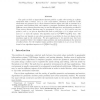Free Online Productivity Tools
i2Speak
i2Symbol
i2OCR
iTex2Img
iWeb2Print
iWeb2Shot
i2Type
iPdf2Split
iPdf2Merge
i2Bopomofo
i2Arabic
i2Style
i2Image
i2PDF
iLatex2Rtf
Sci2ools
SIAMCOMP
2008
2008
Approximate Shortest Paths in Anisotropic Regions
Our goal is to find an approximate shortest path for a point robot moving in a planar subdivision with n vertices. Let 1 be a real number. Distances in each face of this subdivision are measured by a convex distance function whose unit disk is contained in a concentric unit Euclidean disk, and contains a concentric Euclidean disk with radius 1/. Different convex distance functions may be used for different faces, and obstacles are allowed. These convex distance functions may be asymmetric. For any (0, 1) and for any two points vs and vd, we give an algorithm that finds a path from vs to vd whose cost is at most (1 + ) times the optimal. Our algorithm runs in O 2 log 2 n3 log n time. This bound does not depend on any other parameters; in particular it does not depend on the minimum angle in the subdivision. We give applications to two special cases that have been considered before: the weighted region problem and motion planning in the presence of uniform flows. For the weighted reg...
Related Content
| Added | 14 Dec 2010 |
| Updated | 14 Dec 2010 |
| Type | Journal |
| Year | 2008 |
| Where | SIAMCOMP |
| Authors | Siu-Wing Cheng, Hyeon-Suk Na, Antoine Vigneron, Yajun Wang |
Comments (0)

